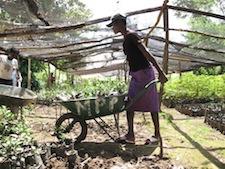Combating Hunger by Reforesting Haiti
Last August, I stood in Haiti’s Artibonite valley with several peasant organizers and looked out at the mountains leading up to the Central Plateau. The older leaders in the group explained in depth how green the mountains once were, while the younger organizers and I listened in amazement. The tropical lime forests they described from their past were the antithesis of the sandy naked slopes we saw in the distance.
Haiti is a prime example of how natural disasters are exacerbated by environmental degradation and centralized development. Haiti continues to have one of the highest rates of soil erosion and deforestation in the world—less than 2% of the country’s natural forest cover remains. Not only does this dramatically diminish water resources and threaten agricultural yield, but it also intensifies the destructiveness of hurricanes, causing deadly mudslides and flooding in areas devoid of vegetation.
Export-driven trade agreements and dependence caused by food aid have concurrently devastated rural Haiti by undermining local production. These are the very policies that caused more than two million rural Haitians to migrate to Port-au-Prince over a period of less than thirty years. The city was completely unprepared to handle the swelling numbers, and most ended up in impoverished dangerous slums and poorly constructed housing.
A decentralized rural development strategy rooted in simultaneous reforestation and food production could have lessened the drastic death toll of the January 2010 earthquake. The reverse migration from the cities to the countryside resulting from this tragedy is a chance to start over. Despite the emergency situation and many setbacks to measurable progress, Haitian peasant organizations are still moving forward with their work and looking to grow.
Haitian peasant movements and organizations provide practical demonstrations of sustainable agricultural methods and practices and act as an example of the way out of poverty. One of these groups, Grassroots International’s partner the Peasant Movement of Papaye (MPP) has been working in Haiti’s Central Plateau for nearly 40 years. Today, the MPP is one of Haiti’s largest and most successful peasant movements with over 60,000 members—20,000 of which are women and 10,000 are youth.
The Central Plateau was one of the most deforested areas in the country before MPP started working there and surrounding areas are still severely parched. While some international organizations, governments, and corporations have eyed the bare land to make room for Jatropha plants for agrofuel production and export, Haitian groups like the MPP recognize that the land should be used to grow healthy food to feed their communities and sustain their livelihoods.
The MPP has developed comprehensive strategies for reforestation, soil conservation and improvement. They consistently create and maintain fruit and forest tree nurseries and farms to replenish both the land and food supply, using entirely organic practices. Since they began this work, the MPP has grown and planted over 20 million trees.
MPP agronomists have identified which trees are native to Haiti and make every effort possible to recreate the natural landscape. “You wouldn’t have believed that it was the same place if you had seen it about 15 years ago,” said MPP agronomist Mulaire Michel against a backdrop of heavy greenery. “Everything we do here is a marriage between food production and soil conservation,” he added.
 In addition to agroecology, MPP supports economic development, trains community groups, and provides health and medicine—and often connects across all areas of work. For example, MPP trains a community group in growing medicinal herbs that can be transformed into marketable products. These products stock the shelves of MPP’s health clinic and the excess is traded at local cooperatives.
In addition to agroecology, MPP supports economic development, trains community groups, and provides health and medicine—and often connects across all areas of work. For example, MPP trains a community group in growing medicinal herbs that can be transformed into marketable products. These products stock the shelves of MPP’s health clinic and the excess is traded at local cooperatives.
As peasants are organized to join these projects, they also participate in popular education programs. Community members explore structural issues such as U.S. foreign policy in Haiti, economic globalization, and other important political, economic, and social realities. It is in large part because of this coupling of community organizing and popular education efforts with “seeds and tools” development that the MPP has been so successful.
Today their labor has come to fruition. The Papaye region of the Central Plateau is now rich with various fruit and forest cover, young forests, and farms—a humble paradise at the crossroads of hardship. Forty years ago, it was a wasteland. The MPP has spearheaded a national peasant coalition (National Congress of the Papaye Peasant’s Movement) in order to reproduce their results elsewhere in Haiti. This coalition is active in all of Haiti’s 10 departments.
Haitian peasant organizers know that local leadership and agroecology works—and they want those factors to lay the foundation of the rebuilding process. If we listen, a new generation of Haitians will be able to show off tropical lime forests and tell the story of just how far they have come.
